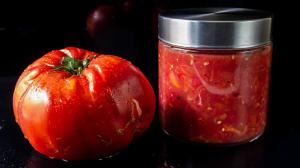PART 1 (of a summer mini-series) of 3 episodes ! ... Here’s a story about how refreshing and surprisingly vibrant RAW & UNCOOKED (and yet still slightly prepared) FRESH & RIPE HEIRLOOM TOMATOES can be and how you can accentuate these same flavors and prepare them without cooking (I mean without applying heat) during a period of the year where HEAT WAVES seem to come and go more often.
And there will be very practical & useful "extras" in addition to the tomato sauce & spread : the "tomato waters" ...
Yeah, the HEAT WAVES. Even though we don’t have air-conditioning nor electric fans in our place (because we don’t want any of that extra stuff), we don’t have a single problem with the heat waves we’ve been having. We actually welcome the heat and the sun with open arms, remaining scantily-clad (because we’re not working this month), with fully open windows and doors to create a draft, taking multiple cold showers during the day, then drying off on the terrace and enjoying the slow pace of these sunny heart and body-warming days with colder and/or barely cooked foods and chilled drinks. It’s like being on vacation before actually, physically and officially going on a vacation.
We enjoy the city’s peacefulness and its emptiness, especially from mid-July to mid-August. We stay in the city when most people (including our friends & neighbors) are away on vacation. We only decide to physically and geographically escape the city when the vacationers all come back around the third week of August, as they’re still reminiscing but also grunting and grumbling that it’s all over. Our vacation calmly and uneventfully begins at home with their absence and then continues with a change of scenery and a hop onto a plane upon their return. This is how we plan things so as to be surrounded by good vibes all the time and we’ll obviously have to take off soon because they’re all coming back soon. But we’ll be equally happy to be back in mid-September after all that ! Are we wrong ?!
Back to the FOOD.
What have I DONE here ? Or to be more precise, what have I NOT DONE here ? Well, I haven’t cooked all these ingredients into “submission” but actually allowed them to become a harmony of flavors, accentuating and tweaking them into a symphony, with SIMPLICITY and ZENITUDE !
Try to imagine fresh heirloom tomatoes, so ripe or preferably over-ripe, that you can literally squish and crush them with your hands (no cutting tools required), saving every drop of juice and even the seeds, and then straining them into 2 equal volumes and weights of liquids and solids, combining everything with some acidic components like some apple cider vinegar and lemon juice, sea salt and a touch of cane sugar (to counterbalance the acidity), to ultimately draw out, deepen, accentuate and add even more vibrancy to their flavors.
You can actually just stop here because the taste is already fantastic but I continue and also add a variety of fresh herbs and vegetables (the leaves & stems & stalks too) and other elements like sliced or grated garlic and onion or shallot to complexify (is that a real word ?) the whole thing while the ingredients just sit there overnight in a jar, communicating, slowly mingling and getting acquainted, infusing their essences together overnight like long-lost lovers.
But, at some point, a separation must occur, usually in the morning or on the next day. The fleshy solids must be separated from the other plant & vegetables elements like the tougher stems and leaves and the onion and garlic (if you’ve only sliced them but you can crush or grate them later and add them back in for more flavor). This forced separation will not become an issue of abandonment because the fleshy tomato solids retain the memory of the “others” and their “time spent together” and have been made “better & improved”. The “complementarity” and “complicity” of their union continues and survives. And let's not forget that the strained "tomato waters" can & will be useful !
The main elements here are the fleshy solids that will become the sauce and/or spread but the 2 liquids (or tomato waters) will also be used to replace and enhance other ingredients in other preparations, but I’ll show you all that in the next 2 recipes soon.
NOTE : the prepared sauce could be used as is (500 grams) or strained to 70% of its initial weight (350 grams) as a fresh light sauce for pasta dishes but it could be strained even further to 50% of its initial weight (250 grams) for a sauce on roasted or grilled meats & fish but could also strained up to 35% maximum of its initial weight (175 grams) to become a much denser spread-sauce to be used ideally on grilled breads and pizzas !
But even as I’m telling you all of this, I’m working on the 2 other easy recipes using this preparation and coming very soon because I’ll be leaving on vacation too and would like to publish all this before going away. But those recipes will be parts 2 & 3 of this mini-series.
As you all well know, I waste nothing and I like to “multitask” ! You get it ? Anyways, it’s all about those accentuated tomato flavors and what you can do with them.
End of part 1 of this mini-series. Parts 2 & 3 are coming in the next few days or a week, who knows, it's summer ?! . . . :)
















